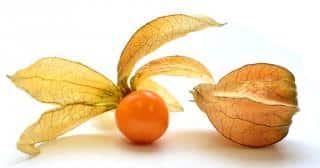

A plant full of health benefits native to Peru, Bolivia and Columbia, Physalis grows near houses and buildings in gardens and even in elevated lands with altitudes above 10,000 feet (3200 meters). It propagates very easily in these environments.
It also grows in rich soil and is abundant in Southeastern Canada.
Known on the world market are two main species that are quite distinct from each other, Physalis alkekengi and Physalis heterophylla. A third slightly less common variety is Physalis peruviana, the Peruvian Coqueret. From a nutritional and medicinal point of view, all these varieties are quite similar even though they differ slightly.
This plant appears in temperate, sub-tropical and tropical climates and bestows various medicinal properties and gastronomical uses.
Which ones?
Let’s have a look around…
The root word “Physalis” comes from Ancient Greek “phusalis” which means “bladder”. This is because the shape of the hull containing the fruit looks like the shape of the bladder in the body.
The name of the variant “Alkekenge” comes from old French “alquequange” which itself came from Arabic “al-kakang“.
The “coqueret” name used refers to an old name for a rooster, “coq“, because the bright red-orange color of the fruit-containing calyx stands out like a rooster’s comb.
Also called “Cape gooseberry”, the plant was grown by the first colonizers to reach the Cape of Good Hope, from where the plant was brought to Australia and Chili. In those countries it is grown on an industrial scale.
It’s very famous nowadays in Central Africa, more specifically in Gabon and South Africa, where the fruit is produced for commercial export.
A plant that belongs to the Solanaceae family, physalis grows up to 1½ feet to 3 feet tall (45 to 90 cm). It sends up shoots that branch out quite a lot.
The leaves are close to oval and sometimes show dented edges.
Chinese lantern bears a surprising calyx that encapsulates a green and oval fruit.
This plant which grows a slight fuzz over its green air-borne parts is know by such names as “ground cherry”, “Cape gooseberry”, “love-in-cage”, “winter cherry”, “Peruvian coqueret”, “Chinese lantern”, “tomatillo”…
But which are its health properties?
Known for its therapeutic properties, this antioxidant-rich plant is a true source of carotenes, provitamin A, vitamin E, phytosterols and vitamin C.
This host of natural health backers also include vitamin B, an exceptional proportion of phosphorus rated at over 55%, and only a tiny portion of protein.
One of the health benefits attributed to Physalis is the fact that it can soothe sore throat.
Better yet, it also reinforces optical nerves.
Very often, specialists recommend using this plant to treat patients who suffer prostate disorders or any type of diabetes.
Its diuretic properties are said to purify our blood.
As for its flavonoid contents, Cape gooseberry is also used as a natural tranquilizer.
This well-known winter cherry was widely used to treat kidney and liver diseases and also to adjust metabolic activity.
It was also advised to use Physalis to treat jaundice, hydropsy, urine retention and even to lower fever.
Peruvian groundcherry also eliminates uric acid: this made it an excellent natural remedy to treat rheumatism problems.
A dicotyledon plant just like potato, tomato, bell pepper, eggplant and chili, Peruvian coqueret is also closely related to poisonous plants like henbane or bittersweet.
Because its fruit and hull is very fragile, harvesting Physalis is a delicate manual task.
The fruit can be eaten fresh as is, and sweetened in the form of jam.
However, adding pectin is required because physalis doesn’t contain any natural gelling agent.
When dried, the fruit is eaten both with sweet dishes and main courses.
This very delicate fruit is very much sought after when preparing pies.
Usually, the physalis berries or the groundcherry juice is used as a remedy.
To ingest them, it is a good idea to slice the stems lengthwise to speed up they drying process.
Fresh physalis berries can be ingested:
– in decoctions.
For that, weigh out 0.7 to 2 oz (20 to 60 g) dried berries per quart (liter) water. Boil for 5 minutes, and let steep for about 10 minutes before drinking.
– as a maceration of the entire plant (fruits, leaves and stem) in white wine for 8 days. Filter and drink 1 cup a day.
About 1 oz (30 g) for 1 quart (1 liter) is the right amout.

However, when still green and unripe, these fruits have a high solanin content: this can lead to diarrhea or gastro-enteritis if ingested.
Teach children not to eat it.
According to some accounts, even the leaves and stems of the winter cherry might be poisonous.
Note also that physalin is one of the active ingredients of the Physalis genus.
When ingested in high doses, it may be abortifacient.
It is thus highly recommended that pregnant women not ingest it.
If you’re already following a course of medicine treatment, talk to your pharmacist or consulting physician before taking up herbal products.
Having a sound medical opinion is important.